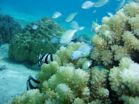(Press-News.org) Researchers at the University of Hawaii – Manoa (UHM) School of Ocean and Earth Science and Technology (SOEST) made a discovery that challenges a major theory in the field of coral reef ecology. The general assumption has been that the more flexible corals are, regarding which species of single celled algae (Symbiodinium) they host in coral tissues, the greater ability corals will have to survive environmental stress. In their paper published August 29, 2012, however, scientists at the Hawaii Institute of Marine Biology (HIMB) at SOEST and colleagues documented that the more flexible corals are, the more sensitive to environment disturbances they are.
"This is exactly the opposite of what we expected," said Hollie Putnam, PhD candidate at UHM and lead author of the study. This finding was surprising, as it is thought corals exploit the ability to host a variety of Symbiodinium to adapt to climate change. "Our findings suggest more is not always better," she continued.
"The relationship of coral species to their algal symbionts is fundamental to their biology," says David Garrison, program director in the National Science Foundation (NSF)'s Division of Ocean Sciences, which funded the research. "This study gives us a new understanding of how corals are likely to respond to the stresses of environmental change."
Reef corals are the sum of an animal (host), and single celled algae that live inside the corals' tissues (also called 'endosymbionts'). This is a mutually beneficial arrangement – the coral provide protection and keep the algae in shallow, sunlit seas; and the algae produce large amounts of energy through photosynthesis, which coral use to survive and build their skeletons. The stability of this symbiosis is critical to the survival of corals and if they lose their endosymbionts they bleach and often die. Corals can host different types of endosymbionts, which affects their response to stress.
Putnam and other scientists from Dr. Ruth Gates' laboratory at HIMB took tiny tissue samples from 34 species of coral in Moorea, French Polynesia. By analyzing the DNA from the endosymbionts in these samples, they were able identify the types of Symbiodinium. This revealed that some corals host a single Symbiodinium type that is the same in all individuals of that coral species, and that others host many types that vary among individuals within a coral species.
"The corals we sampled spanned a range of environmental sensitivities from resistant to susceptible, and we were able to link, for the first time, patterns in environmental performance of corals to the number and variety of symbionts they host," reported Putnam. These patterns show that corals hosting diverse Symbiodinium communities, those that are flexible with respect to endosymbionts (termed 'generalists'), are environmentally sensitive. In contrast, environmentally resistant corals were those that associate with one or few specific types of Symbiodinium (termed 'specifists').
"Coral reefs are economically and ecologically important, providing a home for a high diversity of organisms necessary for food supplies, recreation, and tourism in many countries. The better we understand how corals respond to stress, the more capable we will be to forecast and manage future reefs communities," said senior author Professor Ruth Gates. Coral reefs can undergo mass mortality due to high temperatures, and ocean acidification is threatening the capacity for skeletal growth. These global stressors are superimposed on the local threats of pollution, coastal development and overfishing, together threatening the persistence of corals as a functional ecosystem in the future.
In the future, the Gates Lab will examine what causes the differences in success between corals that are flexible and inflexible in their Symbiodinium associations and compare the symbiotic flexibility in corals and reefs across much larger areas – in locations such as Hawaii, Moorea, Taiwan and American Samoa. This further understanding will allow better predictions of the future of reefs under further ocean warming and acidification.
INFORMATION:
The research was conducted at NSF's Moorea Coral Reef Long-Term Ecological Research (LTER) site, one of 26 such NSF sites around the globe in ecosystems from coral reefs to freshwater lakes, and from forests to grasslands. To read the Award Abstract for this work, visit http://www.nsf.gov/awardsearch/showAward.do?AwardNumber=0417412
Proceedings of the Royal Society B: Endosymbiotic flexibility associates with environmental sensitivity in scleractinian corals; Hollie M Putnam, Michael Stat, Xavier Pochon, and Ruth D Gates
For more information about the research activities from the Ruth Gates Lab, visit http://www2.hawaii.edu/~rgates/Gates_Lab_Website/Gates_Lab.html
To learn more about the National Science Foundation-funded Moorea Coral Reef Long Term Ecological Research program, please visit http://mcr.lternet.edu/
Less is more for reef-building corals
Inflexibility of coral host leads to higher resistance to environmental stresses
2012-08-29
ELSE PRESS RELEASES FROM THIS DATE:
Small family size increases the wealth of descendants but reduces evolutionary success
2012-08-29
Scientists have taken a step closer to solving one of life's mysteries – why family size generally falls as societies become richer.
Evolutionary biologists have long puzzled over this because natural selection is expected to have selected for organisms that try to maximise their reproduction. But in industrialised societies around the world, increasing wealth coincides with people deliberately limiting their family size – the so-called 'demographic transition'.
In a study published in Proceedings of the Royal Society B: Biological Sciences, researchers from the London ...
Kepler discovers planetary system orbiting 2 suns
2012-08-29
Astronomers at the International Astronomical Union meeting announced the discovery of the first transiting circumbinary multi-planet system: two planets orbiting around a pair of stars. The discovery shows that planetary systems can form and survive even in the chaotic environment around a binary star. And such planets can exist in the habitable zone of their stars. "Each planet transits over the primary star, giving unambiguous evidence that the planets are real," said Jerome Orosz, Associate Professor of Astronomy at San Diego State University and lead author of the ...
NASA, Texas astronomers find first multi-planet system around a binary star
2012-08-29
Fort Davis, Texas — NASA's Kepler mission has found the first multi-planet solar system orbiting a binary star, characterized in large part by University of Texas at Austin astronomers using two telescopes at the university's McDonald Observatory in West Texas. The finding, which proves that whole planetary systems can form in a disk around a binary star, is published in the August 28 issue of the journal Science.
"It's Tatooine, right?" said McDonald Observatory astronomer Michael Endl. "But this was not shown in Star Wars," he said, referring to the periodic changes ...
Why are there so many species of beetles and so few crocodiles?
2012-08-29
There are more than 400,000 species of beetles and only two species of the tuatara, a reptile cousin of snakes and lizards that lives in New Zealand. Crocodiles and alligators, while nearly 250 million years old, have diversified into only 23 species. Why evolution has produced "winners" — including mammals and many species of birds and fish — and "losers" is a major question in evolutionary biology.
Scientists have often posited that because some animal and plant lineages are much older than others, they have had more time to produce new species (the dearth of crocodiles ...
Space-warping white dwarfs produce gravitational waves
2012-08-29
Gravitational waves, much like the recently discovered Higgs boson, are notoriously difficult to observe. Scientists first detected these ripples in the fabric of space-time indirectly, using radio signals from a pulsar-neutron star binary system. The find, which required exquisitely accurate timing of the radio signals, garnered its discoverers a Nobel Prize. Now a team of astronomers has detected the same effect at optical wavelengths, in light from a pair of eclipsing white dwarf stars.
"This result marks one of the cleanest and strongest detections of the effect of ...
NASA watching Isaac's approach to US Gulf Coast
2012-08-29
VIDEO:
An animation of satellite observations from August 26-28, 2012 shows Tropical Storm Isaac moving past the Florida Keys and into the Gulf of Mexico, nearing landfall in the U.S. Gulf...
Click here for more information.
NASA satellites have been providing valuable data to forecasters at the National Hurricane Center watching the development and progression of powerful Tropical Storm Isaac as it heads for landfall.
The Moderate Resolution Imaging Spectroradiometer ...
Having to make quick decisions helps witnesses identify the bad guy in a lineup
2012-08-29
Eyewitness identification evidence is often persuasive in the courtroom and yet current eyewitness identification tests often fail to pick the culprit. Even worse, these tests sometimes result in wrongfully accusing innocent suspects. Now psychological scientists are proposing a radical alternative to the traditional police lineup that focuses on eyewitnesses' confidence judgments.
In a new article forthcoming in Psychological Science, a journal of the Association for Psychological Science, Neil Brewer of Flinders University and colleagues report a new type of lineup ...
Study finds gene that predicts happiness in women
2012-08-29
Tampa, FL (Aug. 28, 2012) -- A new study has found a gene that appears to make women happy, but it doesn't work for men. The finding may help explain why women are often happier than men, the research team said.
Scientists at the University of South Florida (USF), the National Institutes of Health (NIH), Columbia University and the New York State Psychiatric Institute reported that the low activity form of the gene monoamine oxidase A (MAOA) is associated with higher self-reported happiness in women. No such association was found in men.
The findings appear online ...
Can branding improve school lunches?
2012-08-29
A popular marketing ploy with junk foods and other indulgent table fare can be an equally effective tool for promoting healthier eating in school cafeterias.
"Nutritionists and school lunch planners can turn the tables on children's poor eating habits by adopting the same 'branding' tactic used by junk food marketers," said Brian Wansink, an expert on the subtle cues that affect people's eating habits and professor of marketing at the Dyson School of Applied Economics and Management at Cornell University.
Food marketers have associated particular foods with mascots, ...
The beat goes in the brain
2012-08-29
URBANA, Ill. — Like a melody that keeps playing in your head even after the music stops, researchers at the University of Illinois's Beckman Institute have shown that the beat goes on when it comes to the human visual system.
In an experiment designed to test their theory about a brain mechanism involved in visual processing, the researchers used periodic visual stimuli and electroencephalogram (EEG) recordings and found, one, that they could precisely time the brain's natural oscillations to future repetitions of the event, and, two, that the effect occurred even after ...
LAST 30 PRESS RELEASES:
Low daily alcohol intake linked to 50% heightened mouth cancer risk in India
American Meteorological Society announces Rick Spinrad as 2026 President-Elect
Biomass-based carbon capture spotlighted in newly released global climate webinar recording
Illuminating invisible nano pollutants: advanced bioimaging tracks the full journey of emerging nanoscale contaminants in living systems
How does age affect recovery from spinal cord injury?
Novel AI tool offers prognosis for patients with head and neck cancer
Fathers’ microplastic exposure tied to their children’s metabolic problems
Research validates laboratory model for studying high-grade serous ovarian cancer
SIR 2026 delivers transformative breakthroughs in minimally invasive medicine to improve patient care
Stem Cell Reports most downloaded papers of 2025 highlight the breadth and impact of stem cell research
Oxford-led study estimates NHS spends around 3% of its primary and secondary care budget on the health impacts of heat and cold in England
A researcher’s long quest leads to a smart composite breakthrough
Urban wild bees act as “microbial sensors” of city health.
New study finds where you live affects recovery after a hip fracture
Forecasting the impact of fully automated vehicle adoption on US road traffic injuries
Alcohol-related hospitalizations from 2016 to 2022
Semaglutide and hospitalizations in patients with obesity and established cardiovascular disease
Researchers ‘listen in’ to embryo-mother interactions during implantation using a culture system replicating the womb lining
How changing your diet could help save the world
How to make AI truly scalable and reliable for real-time traffic assignment?
Beyond fragmented markets: A new framework for efficient and stable ride-pooling
Can shape priors make road perception more reliable for autonomous driving?
AI tracks nearly 100 years of aging research, revealing key trends and gaps
Innovative techniques enable Italy’s first imaging of individual trapped atoms
KIER successfully develops Korea-made “calibration thermoelectric module” for measuring thermoelectric device performance
Diversifying US Midwest farming for stability and resilience
Emphasizing immigrants’ deservingness shifts attitudes
Japanese eels, climate change, and river temperature
Pusan National University researchers discover faster, smarter heat treatment for lightweight magnesium metals
China’s 2024 Gastroenterology Report: marked progress in endoscopy quality and disease management
[Press-News.org] Less is more for reef-building coralsInflexibility of coral host leads to higher resistance to environmental stresses





